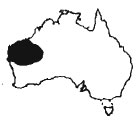Varanus Cavdolineatus
 |
Stripe-tailed goanna
V.caudolineatus is a small monitor lizard that occurs only in Western Australia. It does not appear to live around the coast nor on any offshore islands (Storr 1980). Favoured habitats are grasslands. shrublands and woodlands and it appears to inhabit a wide range of Acacia and spinifex dominated habitats (Storr & Harold 1978; Storr & Hanlon 1980; Pianka 1969; Schmid a 1975). They are usually found beneath bark or in tree hollows and in areas with rock outcrops they take shelter in vertical and to a lesser extent, horizontal crevices. In the Pilbara they are said to inhabit river banks (Bush 1987 & pers.comm .. ) but they are also found in very dry areas. For shelter they prefer very small spaces which they can wedge themselves into (Bennett 1991; Thompson 1993).
The stripe-tailed goanna reaches a maximum size of about 32cm TL. A specimen I examined at Wanjarri in March measured 11.2cm SVL (tail 13.5cm) and weighed 4.5g. Smith (1988) records the weight of a heavily gravid female as 37g. The tail of V.caudolineatus does not possess spines. but the scales are often strongly keeled. Storr (1980) noted that specimens from more northerly locations grow larger and more closely resemble V.gilleni.
The stripe-tailed goanna is usually encountered in trees but may find most of its food on the ground. Its diet consists entirely of invertebrates (roaches. orthopterans. spiders. scorpions. centipedes and lepidopterans) and other lizards (geckoes and skinks) (Pianka 1969. 1994; Losos & Greene 1988; Thompson 1993). They commonly eat the tails of geckoes that are otherwise too big to swallow. Pianka (1969) found that they were active only during the hottest months of the year and suggested that the clutch of 4-5 eggs was laid in December. Smith (1988) collected a gravid female in late October that laid four eggs a month later weighing 12.4g in total (over a third of the body weight). In the desert their major enemies are probably larger goannas (Pianka 1994).
A study by Thompson (1993) found that stripe-tailed goannas may live in close association with each other (he found four specimens in 0.005km2). Because of their love of tight spaces the use of radiotransmitters to track their movements is impractical. Thompson got round this problem by marking the animals with small amounts of labelled sodium and tracking them with a Geiger counter. He found that the lizards were only active during the wannest part of the day (i.e. at temperatures of 30-45.5°C) and moved only short distances compared with other species of a similar size (average of 34m from one tree shelter to another) and would remain in the same tree for as long as 15 days (average of 3 days). Mean active body temperature of 10 specimens was 37.8°C (Pianka 1982). Ritual combat is described by Thompson et al 1992.
Other than the account given by Smith (1988) whose eggs failed to hatch there is very little in the literature concerning the care of this species in captivity (Minke 1914; Schmida 1975). Males and females look identical and may be very tolerant of each other. A diet of insects and tiny mammals should be suitable. Because of the small size and relatively sedentary behaviour of this species they can be kept in smaller enclosures (0.5- 1m2) providing they have the opportunity to climb and hide above the ground.
Attribution / Courtesy: Daniel Bennett. 1995. A Little Book of Monitor Lizards. Viper Press U.K.




